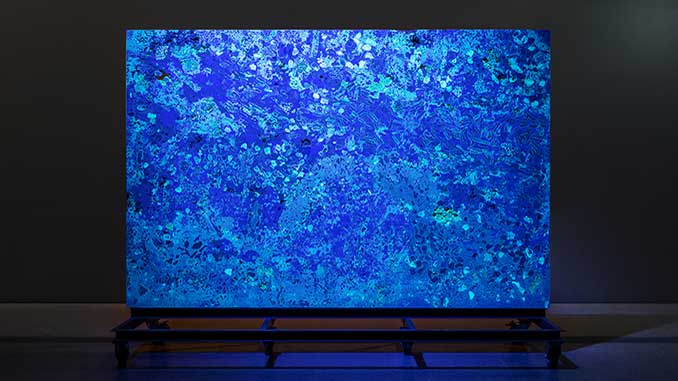 The first comprehensive survey exhibition by Australian artist Nicholas Mangan, A World Undone opens today at the Museum of Contemporary Art Australia (MCA Australia), on display until 30 June 2024.
The first comprehensive survey exhibition by Australian artist Nicholas Mangan, A World Undone opens today at the Museum of Contemporary Art Australia (MCA Australia), on display until 30 June 2024.
Nicholas Mangan (b. 1979, Djilang/Geelong) describes his sculptural installations as a form of ‘material storytelling’. Over the past two decades he has created works that consider humanity’s relationship to the natural world, taking everything from coral rubble to cryptocurrency as a point of departure.
Mangan’s art locates human history in the context of deep geological time. With a focus on Australia’s place in the Pacific, his works examine how social, political and economic upheaval are connected to material transformation, offering new perspectives on pressing global issues, such as the impact of extractive mining on natural resources and climate change.
Curated by the MCA Australia’s Anna Davis and Anneke Jaspers, Nicholas Mangan: A World Undone brings together eight of the artist’s expansive sculptural projects.
The exhibition takes its title from an artwork by Mangan in the MCA Collection – A World Undone (2012) – which was made using a rock sample containing zircon, the oldest known mineral on Earth. Nearby, a video that considers our connection to the sun – Ancient Lights (2015) – is powered by an off-grid solar array installed on the MCA roof.
A trio of projects engaged with the Pacific is also on display: Nauru – Notes from a Cretaceous World (2009–10), which reflects on the impact of phosphate mining on the small island nation of Nauru and its complex socio-political history; Progress in Action (2013), an installation that considers events linked to the Panguna copper mine in Bougainville; and Limits to Growth (2016–21), which compares Bitcoin with Rai, an ancient form of stone money from the Micronesian island of Yap.
“Many of my projects are centred around specific historical events where a social, economic, and political rupture has occurred, often involving multiple compounding forces acting on matter from various directions,” said Artist Nicholas Mangan.
Around such events there already exists an expanded series of actions that I would argue are sculptural – processes by which humans force materials into flows, compressions, divisions, extractions, redistributions, and re-aggregations.”
“As a result of such processes, new assemblages are formed. This happens within nature itself, but I am particularly interested in how humans engage and alter the natural world at various scales,” said Mangan.
“Nicholas Mangan is part of a generation of contemporary artists who are taking the language of sculpture to new limits. His work interconnects the conventions of monumental sculptural forms with cryptocurrency, extraction, and climate change, and speaks eloquently to our contemporary world,” said MCA Australia Director, Suzanne Cotter.
Exhibition highlights include the major new project Core-Coralations (2021–ongoing), which draws parallels between human and coral futures. As part of his research, the artist visited Queensland’s coral-rich Heron Island and the National Sea Simulator (SEASIM) in Townsville.
The sculptures have been shaped by his encounters with the vibrant reef and with coral ‘core’ specimens in the SEASIM research lab, coupled with observations of the many pressures acting on this ecosystem.
Tropical and subtropical reefs are acutely vulnerable to rising sea temperatures due to climate change, making their decline an early distress signal for planetary catastrophe.
The largest sculpture, Death Assemblage (2022), is a monument to the coral death toll that riffs on the form of a billboard. Mangan employs ultraviolet light reminiscent of crime scene forensics and marine science to activate a bioluminescent pigment embedded in the sculpture, revealing coral skeletons within its composite surface.
The slab’s intermittent blue glow echoes the fluorescence displayed by corals as a protective response during mass bleaching events. Mangan describes this process as being “like an alarm or a beacon – the effect of a type of chemical sunscreen that reefs emit in response to heat stress.”
Termite Economies (2018–20) is a fascinating series of sculptures made using 3D printing technologies, which combine references to mining infrastructure, termite nests and the human brain.
The works are inspired by a CSIRO report from the early 2000s, which suggested the natural behaviour of termites could be harnessed for economic gain by helping to pinpoint gold and other precious minerals in the vast Australian landscape.
Taking the concept of ‘gold mining termites’ as a starting point, Mangan speculates on the future role of non-human intelligence and labour. The sculptures were developed in three distinct phases.
Phase 1 draws from actual mining substructures including the highly automated Tindals Gold Mine in Western Australia – re-imagined by Mangan at ‘termite miner’ scale.
In Phase 2, the sculptures reference low-resolution bitmap imaging, a process often used in pest extermination to predict the movement of termites through buildings.
Made of repeating forms, these sculptures hint at the types of mining found in the digital economy such as ‘data mining’, which is based on extracting value from the collective activities of human society.
In Phase 3, the sculptures resemble brains fused with termite nests. In these works, Mangan questions whether the natural world itself might be thought of as conscious.
The exhibition is accompanied by a series of public programs and a major new monograph co-published by the MCA and Lenz Press, Milan.
Nicholas Mangan: A World Undone
Museum of Contemporary Art Australia (MCA Australia), 140 George Street, The Rocks (Sydney)
Exhibition: 5 April to 30 June 2024
Free entry
For more information, visit: www.mca.com.au for details.
Image: Nicholas Mangan, Death Assemblage, 2022, coral, aragonite, gypsum, bioluminescent pigment, ultraviolet light, mild steel, enamel paint, installation view, Melbourne Now, National Gallery of Victoria, 2023, image courtesy the artist and Sutton Gallery, Australia © the artist, photograph: Andrew Curtis
